new posts in all blogs
Viewing: Blog Posts Tagged with: races, Most Recent at Top [Help]
Results 1 - 25 of 39
How to use this Page
You are viewing the most recent posts tagged with the words: races in the JacketFlap blog reader. What is a tag? Think of a tag as a keyword or category label. Tags can both help you find posts on JacketFlap.com as well as provide an easy way for you to "remember" and classify posts for later recall. Try adding a tag yourself by clicking "Add a tag" below a post's header. Scroll down through the list of Recent Posts in the left column and click on a post title that sounds interesting. You can view all posts from a specific blog by clicking the Blog name in the right column, or you can click a 'More Posts from this Blog' link in any individual post.
So my plan to do my first triathlon in twenty years on Monday didn't turn out so well.
It rained.
A lot. But not so much in town.
At Camp Mabry, just north of central Austin, we got less than an inch of rain last Thursday. At Bergstrom Airport, just south and east of downtown, they got about nine inches. And it was much worse farther east, along the Colorado River (which also runs through Austin).
On Friday and Saturday, it rained in the Hill Country. West of Austin. Upriver.
On Sunday, there was the CapTexTri expo and packet pickup and bike dropoff.
 |
| Swag! My first cowboy hat since I was around seven. |
 |
| Bike drop off. I got there early. |
 |
| Packet pickup |
 |
| Coveting my neighbor's bike, Part I. |
It was clear and sunny. But because of all the rain, the LCRA opened at least one floodgate from the Tom Miller Dam, releasing water into Lady Bird Lake. Which was where the swim portion of the CapTexTri was supposed to take place.
At the course talk at the expo, they announced that there was a flow of about 3 mph and they were considering changing the course so that it ran point to point (downriver).
 |
| Course talk. Could've used a projector. |
Later that day, they announced the swim was canceled. Which was disappointing, but I've weathered a couple of triathlons in Chicago where that had happened and one when it probably should've.
Monday, race day, I awoke at 5 AM, fed the cats, ate breakfast and drank coffee, and then I heard rain. Lots of rain.
Nevertheless (discovering, to my chagrin, that I am apparently an optimist), I headed out. When I arrived at the transition area, I was told it was closed, and that we should shelter at Palmer Events Center or its garage. This was around 6-620.
In the garage and on the deck of the Palmer Events Center, folks seemed to take things in stride and with humor. Some people were concerned about hairpin turns on a wet course, but were generally willing to take it slow.
 |
| Sheltering in the garage |
We heard a tentative plan to cut short the bike portion to 20k, but the rain and lightning continued. Finally, at around 830, race officials called off the bike portion entirely because of flooding on the course.
 |
| Still a bit lightning-y |
They announced that Olympic distance participants could do a 10k, while sprint participants could do a 5k and that start time would be at 10 am. Most folks removed their bikes and went home or back to their hotels. There was some grumbling -- last year the event had been cut short due to flooding, as well, and I gather there had been similar problems in 2014, too.
 |
| Athletes clearing out the transition area |
I took my bike back to my car, but decided that I'd gotten up at five that morning to run a race and so, I was going to do one. Besides, I didn't want to waste all those carbs I'd eaten in the past few days. :-).
At ten o'clock, the rain pretty much stopped. And then we were off! By 10:15, the sun came out. No, really.
 |
| Everyone who's still there seems in good humor :-) |
 |
| And we're off! |
Turned out, there were only about 200 of us who stuck around for the 10k, with another 150 for the 5k (out of around 3000 original participants), but everyone seemed to be having a good time. I was pretty happy with my race -- I'm not sure it was exactly 10k, but I still did one of my better overall times and paces. At least this century :-).
 |
| The view from the Biergarten. Note the utter absence of rain. |
 |
| Sunny skies. |
On the whole, it was a bit surreal but fun, although in the moment sometimes frustrating. And, in retrospect, kind of funny. I think the organizers did a good job under trying conditions and kept us pretty well informed via social media. So, thanks (And I am really glad I wasn't in charge :-)). Thanks also to all the volunteers who stuck around to the bitter end.
Oh, and I actually ended up getting a bit of a tan.
 |
| Coveting my neighbor's bike, Part II |
Epilogue: Late Monday, the Austin Fire Department closed Lady Bird Lake and Lake Austin to all boat traffic.
And they're giving us a discount for the 2017 race. :-).
Here's what the lake looked like Tuesday morning:
Monday I'm going to be running in the 25th Capital of Texas Triathlon! It's my first triathlon (Olympic distance) in twenty years and I'm pretty jazzed.
 |
| Steely-eyed determination 20 years ago. :-) |
One of the great things about triathlons (and running races in general) is that you get to occupy unusual spaces: the last ones I did were Leon's Triathlon in Hammond, Indiana, a couple of Bud Light triathlons and others in Chicago. Leon's had a swim in Wolf Lake (shudder), followed by a cycle leg on an elevated highway that ran past the old U.S. Steel plant, and a run leg through an industrial downtown. The Chicago ones were on the lakefront, just north of Navy Pier, with a bike on Lake Shore Drive and a run along the lake.
 |
| 2013 CapTexTri |
The CapTexTri also has a great location in downtown Austin, with a 1.5k swim in Lady Bird Lake; a 40k (24.8 mile) bike on a quadruple loop through downtown Austin, including Congress Avenue and Cesar Chavez; and a 10k (6.2 mile) run through Zilker Park.
The only thing I'm not too keen on is the bike route, since it requires you to do the same loop four times. I don't like loop routes because I always think of how many more times I have to do the thing...Still, going up and down Congress Avenue without any cars is going to be pretty cool. As long as there are no poles in the middle of the road, I should be okay. :-).
 |
| Don't ask. |
I feel fairly good about my training. I've maintained good running mileage after the Austin Marathon and Austin Distance Festival and got some good workouts in even while traveling doing school visits.
 |
| On Stone Arch Bridge in Minneapolis |
The swim is probably my weakest event -- I could stand to do more work on technique and probably do more open water swimming, but the distance won't be an issue. Also, Lady Bird Lake isn't going to have waves (I seem to recall a couple of triathlons in Chicago with 3-4 foot waves on Lake Michigan (and this was on the near side of the breakwater). Also, I won't have to deal with a wet suit. My biggest concern is to not get kicked in the face. :-).
 |
| Lady Bird Lake during 2013 CapTexTri |
The bike I'm feeling good about as well. I'll be using the bike I used for my triathlons back in the day - a Trek 1000 I bought when I was in grad school for $450 (a guy at one bicycle shop here tried to sell me a new one, asking if I had a "nostalgic attachment" to it.). I do, but I also don't think a new bike is going to drastically transform my performance. At least not $2000 worth :-). (A guy at another bike shop told me the Trek 1000 was his first road bike and he wished he still had it. It's possible he was being kind :-)).
Tomorrow is packet picket, bike drop-off, and a chance to scope out the transition area, which I'll need because I can't see without my glasses...:-)
Oh, well. Onward!
 |
| The famous Distance Challenge fridge magnets |
It's been a few months, but I finally have some time to sit down and blog my having completed the
Austin Distance Challenge (long course), sponsored by the
Austin Runners Club. I'd done most of the events before, but decided to do the challenge itself (six races, culminating in the
Austin Marathon), because I wanted to put more structure into my training for the marathon. I'd done several in the 90s, but this was my second of the century and I wanted to do better than my last one (2013).
The first race was the
Run Free Texas 80s 8k (for those who don't think in metric, that's about five miles) up in Cedar Park. Naturally enough, there were a couple of DeLoreans, each outfitted with a flux capacitor. Time travel being what it is, they were obviously the same car but from different time periods. :-). The course was through residential neighborhoods and parks and had some rolling hills -- nice for a beginning of the season race.
 |
| Back to the Future! |
The second race of the Challenge was the
Run for the Water Ten Miler. The course was along Lady Bird Lake and up through Tarrytown and then back downtown, There were some great hills on this course and let me know I needed more hill work...And, ironically enough, it was raining. :-)
 |
| Rain and hills |
Race three was the
Decker Challenge, a half marathon in early December with a course around Decker Lake. It's notorious for hills and really bad weather. (The last time I ran it, it was in the 40s and pouring rain). If anything, last year, it was a bit too warm. The hills were pretty brutal, though.
 |
| My face when attacking the hills |
But Santa was there!
After that, we had a month break until the
Rogue Distance Festival 30k (about 18.6 miles) in early January. This one was fairly cold and probably my least favorite of the events. It was up in Cedar Park again and ran through residential neighborhoods which was fine. There was an issue with marking the course, though, so most of us got off track, which meant the mile markers were out of order so it was impossible to figure out a pace. (I think at some point, we were going in circles -- and ended up going about a mile farther than we should've.). Still, it was my longest run before the marathon and I was kind of glad it happened that way.
 |
| Yay! I'm done! :-) |
With four events done, it was all downhill from there. Literally. The
3M Half Marathon starts up in the Great Hills area and runs a straight line down to downtown. It also has a swag bag filled with useful (and not so useful) 3M products.:-)
 |
| Leo checks out the swag bag |
This one also started out pretty cold and way too early :-).
 |
| Before dawn, in the warm car before the cold race. |
I really enjoyed this one, though, and it was a nice preview of many of the neighborhoods on the marathon route.
 |
| Finisher! |
The piece de resistance, of course, was the
Austin Marathon in mid-February. I like the course, but the first time I ran the Austin Marathon, it was all downhill, starting up north and snaking its way downtown. Now, there's a good bit of uphill until around mile 18. I still like the course, though, and it's not like the hills from the Decker Challenge or the Run for the Water races.
I was pretty happy with my time -- my second fastest of the century! I did it in under 4 hours, which had been my goal. Next year, I'll work more on speed, but this time, I just wanted to not have my quads seize up in the last two miles :-).
 |
| Running through UT campus |
 |
| Made it! Best time of the century! |
Anyway, thanks to everyone involved in putting on the races and the challenge itself: organizers, volunteers, emergency personnel, and all the rest! You keep Austin running!
.jpeg?picon=3498)
By: Cait,
on 12/4/2014
Blog:
Cait's Write...
(
Login to Add to MyJacketFlap)
JacketFlap tags:
off season training,
tips,
running,
motivation,
art,
goals,
training,
track,
races,
Add a tag
When you close your eyes, may you dream of lanes, miles, and splits.

It’s never too early to dream of track, or any running goals for that matter. But at a time in the season where your next race may night be quite close enough to ‘taste’…the motivation to brave the elements (Hello, Winter, I was over you last month.) can wane for some runners.
I often take the snarky, or sarcastic, side to life, even when it comes to a ‘kind’ kick in the right direction. Here are some ways I suggest keeping yourself consistent until it IS close enough to ‘taste’ your next race.
1) That Runner Guilt Factor: I’ll be totally honest, this is usually my BEST way to combat a motivation lull. I remind myself that skipping a run usually is not worth feeling that ‘runner guilt’ later. No joke, you know it’s not fun going to bed tossing and turning because you caved to an instance of laziness.
2) The Endorphin Factor: Close to the above, I also remind myself that even if I feel tired/sluggish and the last thing I want to do is run…that usually changes after the first 5 minutes or mile. Once you get into the run those endorphins kick in, and I’ve never finished and thought, “Wow, I really wish I woulda just kicked it on the couch.”
3) Play Antagonizer: Mental dialogue, “C’mon, don’t be a weenie. Suck it the heck up, lace it up.”
4) The Buddy System: When in doubt, call a friend, arrange a run, join a group, social media that you ARE going for a run. That way if you back out, you’ve got to deal with the ‘Tweet of shame’ later. Good peer pressure and all that jazz.
5) Training Program: If you’re training to PR, I have to say I honestly recommend you have a coach, or are knowledgeable enough yourself to coach yourself. But self coaching is HARD…and it’s a lot easier to not have to ‘think’ about your training. That way, you have someone to tell you what to do, BAM, your job is just to run. Trust me, running is hard business, taking some things off your plate is nice. Plus, if your coach gives you the workout, no arguments, lace it up, Buddy!
6) Dream of Goals: Even if race day IS far away, write it down and know your goals. Like the picture above, if you VISUALIZE what you want and put it OUT THERE, it makes things feel more ‘real’ and you know what you’re working towards. It’s harder to blow off a written goal, one you dream about, right? Methinks yes.

7) Bribery: It’ll get you everywhere. Bribe yourself with new running gear, think about dessert, splurge on some cool new shoes, dream of pancakes on your run, create a cool playlist…whatever. When it doubt, donut it out…you just have to run first. 
8) Identity: Okay, some people may be all judgmental and say you shouldn’t DEFINE yourself as a runner…but I’ll be honest, a big part of who I am (or at least the parts I tend to like the most! haha) is that I’m a runner. It’s not just a passion of mine, but it’s a way I connect with people, my friends, and a mentality. I know if I’ve run for the day I feel better and am a happier individual. So race or no race, get my miles on.
9) Money in the Bank: Think of all these miles and workouts as money in the bank. The stronger you are going into the ‘meat’ of the season the better you’ll race. Doesn’t that sound logical? Picture your competitors, who do you think will do better come race day, the ones gettin’ ‘er did, or the sofa’ing ‘er did? The uglier the day/workout, the more excited you should be when you tackle it…it’s making you that much tougher.
10) Superiority: Remember that runners are just better. So go run, don’t you want to be part of the cool kids? 
Snark, goals, tough love to yourself…whatever it takes. Dream of miles, and remember you HAVE the support of the entire (awesome) runner community to give you a motivation boost when you need it.

This weekend they will be running the NCAA Cross Country Championships. The pinnacle of excitement for college cross country, I’ve done a few pieces highlighting a few of the front runners vying for the individual title: Shelby Houlihan, Crystal Nelson, and Patrick Tiernan.

Whether you ran cross country in college, or even went to college, or not I urge you to read them because among all of there runs a similar theme: cross country is unique because it blends the individual component of running with the team aspect. As every runner knows, ultimately, a race is against beating yourself, and while track does have a team scoring element, it is in no way like cross country’s.
Here, there is a team of seven, five runners score but don’t think the sixth and seventh man (or runner woman) don’t count. You need all seven because:
1) You never know: We’ve all had days where the gun goes off and it’s clearly not your day. If you’ve got one of your ‘usual’ top five runners amidst a horrible race, you better hope you can rely on your sixth or seventh to step up.
2) The tie: There are classic stories where it comes down to a tie breaker and a win was decided on the number sixth runner…you can bet that runner who proved a win for their team was celebrated that night!
Most importantly, while running is a test against yourself, there is an incredible bond that is formed between training partners. We’ll call is a bond build on suffering, and when you ‘click’ with certain training partners or groups that’s where the magic happens.
A partner, or team, can pull you to YOUR best.
Through the training season, time miles, the work you put in, if alongside a person/team, therein breeds a remarkable enthusiasm. The success of one is a success of the whole, and in the middle of the pain of race day you can dig a little deeper knowing that you’re racing for yourself but also for your team, your friends, the ones who are pushing through their own pain for you too.

Runners graduate, move on, change teams, but the component of having a training partner there to push you remains the same. Out in the ‘real world’ runners have many options in terms of running: solo, with a friend, with a group, finding a team, etc. Each runner decides where running fits into their life and also what ‘kind’ of running they’re doing.
Some crave the solace of a run with no one but themselves, their thoughts, and the pounding of their feet. Ample time for thinking.
Sometimes it is important to be able to grind out a tough workout by yourself because there is an important part of mental training that must occur.
But…I will say if you want to stretch yourself I urge you to try meeting with at least another person for some of those hard workouts. Ideally, a person a tad faster than yourself.
You see, running is ultimately a test against yourself…BUT, it’s because your MIND is (most often) your greatest obstacle. Having another running there ahead of you, giving you chase, is usually just enough to trick your mind into shutting up and letting your BODY prove you are capable of more.
——-
Lots of other new articles on my WRITING PAGE
I don’t update my blog daily but do on my INSTAGRAM and TWITTER FEEDS
To purchase prints of my artwork head to my ART tab! Thank you for respecting the amount of time and creative work that goes into my drawings and not using them without permissions. 
——
1) Did you run for a team ever, be it in high school, college, or beyond?
2) How often do you run by yourself? With anyone else? With a team?
3) Will you make a goal of meeting someone for a hard workout in the not-so-distant future?

Running takes you away, into another world.
One you control.
Here, time is warped.
Shifted, ticking excruciatingly slower or insanely, much too fast.
Tick. Tick. Tick.
The watch can be a cruel master.
No one can truly see this world…
except for you.
The agony of the inner war waging,
workouts and races, outsiders don’t see.
They don’t FEEL.

But we do. Runners feel,
feel things others can’t imagine…
or would just rather choose not to.
Running’s world is at times painful,
torturous, warped,
but always magical.
Freaking magical…
addictive, alluring.
Control.
Is a finicky world.
In the end we don’t fully control this world,
but merely, the decision of whether to enter it or not.
Drop down the rabbit hole, My Friends.


Long runs and long workouts tend to scare people. It can feel intimidating looking down the barrel of a double digit run or mulit-mile repeats. We’re distance runners, we love this stuff, but large quantities of miles (especially faster miles) still intimidate us.
Running and that mental component, can’t escape the mind games. Our bodies are apt to surprise us and prove our limit-setting minds wrong…BUT it’s a matter of pushing past the mind crap (doubts/fears/discomfort) before we can be ‘pleasantly’ surprised.

The best thing about running into new territory, be it your longest run, the most number of long intervals, or the most volume of hard running, they’re all scariest before you do them. Once you’ve conquered the best you’ve proven you’re capable of it and you get a new frame of reference.
Example: You’re afraid of running 10 miles because you’ve never run that far. You then run 10 miles and flash forward a few weeks and 10 miles doesn’t scare you at all. But 14 miles does…sooo, you run 14 miles and the cycle continues.
See how DOING something takes the fear out of it. Let’s up the ante.
You can run 10 miles but now you’re supposed to run them hard. EEK!!! New challenge. Time to fight through it:
4 Steps to Get Through the Grind
1) Relax:
the first part is you gotta stop building the run or workout up into epic proportions. Say with me, “it’s just a workout (or race), all I can is my best, so that’s the goal.” Deflate some of that pressure and take the power away from the workout…give yourself the power by realizing that you’re going to give it your all and THAT is all that can be expected. Times are there for guidance and
motivation to push…but you can’t let them put so much pressure on you that you implode.
 2) Start:
2) Start: easy peasy, right? Funny how fear sort of get muted the
second the gun sounds and you just START freaking running. It has a way of shutting your brain down for a bit or at least taking it down a few notches.
3) Segments: your runner-brain gets overloaded thinking about the WHOLE run (26.2 miles…holy crap!!!) so you break everything down into smaller segments. Think of it like a meal with a zillion courses if you have to. Get through the plate, the miles, the quarter mile, the repeat.
4) Fight and Lie: running isn’t easy and training is painful. You break it down into itty bitty ‘plates’ but even each bite is still hard. (can I push this metaphor any further?) You need to just cycle through the above three steps on repeat…relax, roll, be confident, be smooth…start, click the watch on that next interval and go, make it until you hear the magic Garmin beep of another mile and keep going…segment, make it 100 meters more, run until you pass that guy, stick like GLUE behind the person in front of you and don’t think how far the finish line is in front of you.
Doing all of the above is really a series of lies. The good lies that you use to ‘trick’ your limit-setting brain into proving itself wrong. Your body CAN keep going, you just have to fight like h*ll long enough to show yourself you can do it.
The cool thing is once you get through the grind you’ve just re-calibrated what’s ‘suuuper scary’. Whatever you just did won’t scare you so much next time…
…but don’t rest too easily, Runners, because that just means later the ante will be upped. That’s okay, because you know the drill. 
——
“The Big Three: Talent vs. Work Ethic vs. Mental Toughness- Which matters the most?”
“Effective Mental Strategy: Race better by out-thinking your brain”
——
1) What’s the longest you’ve run?
2) What’s your favorite long repeats workout?
3) How do you get through the grind?

I live in California so even though June 21st is ‘officially’ the first day of summer, I’ve been running in a hot box for weeks already. Never fail, during some of my summer runs I always get that Bush song, “Speed kills…” stuck in my head but I swap out the word to “heat kills”. #truth
Running when the brutal sun is scorching you isn’t my favorite thing. But until we find that perfect seasonless runner utopia we must deal. For those runners in humid states, good lordy I’ve spent some time running in those conditions and had to come back and wrench out my running shorts and sports bra, easily a couple cups of sweat there! haha.
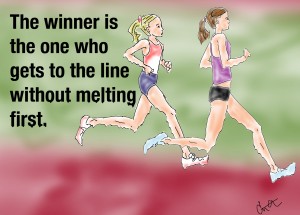
So here’s my running summer warning and tip round-up:
* Beat the Heat:
If you can, it seems like a no-brainer to try and get up and go run before the sun and temps are up, or wait until the later evening.
* Acclimate: Here is where you SHOULD actually force your runner butt to run in the heat. If you’re going to be racing under sweltering conditions you NEED to start getting your body used to running in the same conditions. The first runs, and especially hard workouts, are going to not feel all too pleasant. But eventually your body will start to adjust…you do NOT want the first time you go out and run in hot/humid/both conditions to be on race day when you’ve been doing all of your training at 5am to beat the heat. It’ll be like a body slam sucker-punch on race day.
* Hydrate…they hydrate some more: I’ve done some posts
HERE and
HERE all about hydration. But this needs to be BEATEN into your HEAD here. Hydrate religiously throughout the entire day!! You should be peeing darn near clear, by the time you feel thirsty you’re mildly dehydrated. Also make sure to get those electrolytes replenished as well.
* GI Issues: It’s no coincidence that your tummy may become more upset when the temps rise. I did a post
HERE explaining just how much dehydration can be the root cause of lots of running GI disasters. So another reason to stay hydrated…ooor, just go poop your pants…your choice.

Now let’s talk about doing hard workouts and races in the summer scorchers:
* Easy Does It: We already know that going out too fast can be the kiss of death. Doing that in the heat is like putting yourself through Dante’s extra levels of h*ll. You might feel okay at the start but it’ll come slap you hard in the body/face/legs later. This is where you should be running for EFFORT and not times…the heat and humidity are two big factors that slow down times. So adjust your paces accordingly and the power of negative splitting is much friendlier than the brutal kick your butt punishment of going out too fast.
* H2O Cool: If you’re at the track, bring extra water to douse your head and body between reps. Obviously keep some to take sips on, but getting that body temp down the hose-to-head method works well too.
* Seek Shade: Ahhh-duh. If you can find shadier trails to do tempo or fartlek runs on then it’s a no-brainer (vs. an uncovered track). But I also wanted to add this one in here meaning that if you’re doing a track meet and are doubling/tripling/etc. get you butt in the shade as much as possible. No need to have extra energy zapped out of you lingering in the sun unnecessarily.
Whew…and after that, just dream of ice cream and guzzling the entire river once you’ve finished the run. 
1) What’s one of your summer running tips?
2) How bad are you tan lines?
I could blind you from 10 miles away. 

.jpeg?picon=3498)
By: Cait,
on 6/15/2014
Blog:
Cait's Write...
(
Login to Add to MyJacketFlap)
JacketFlap tags:
running,
motivation,
art,
drawing,
goals,
exercises,
races,
Sunday Morning Inspiration,
sunday morning motivation,
Add a tag
Moments before the gun. All other runners slip away, left one.
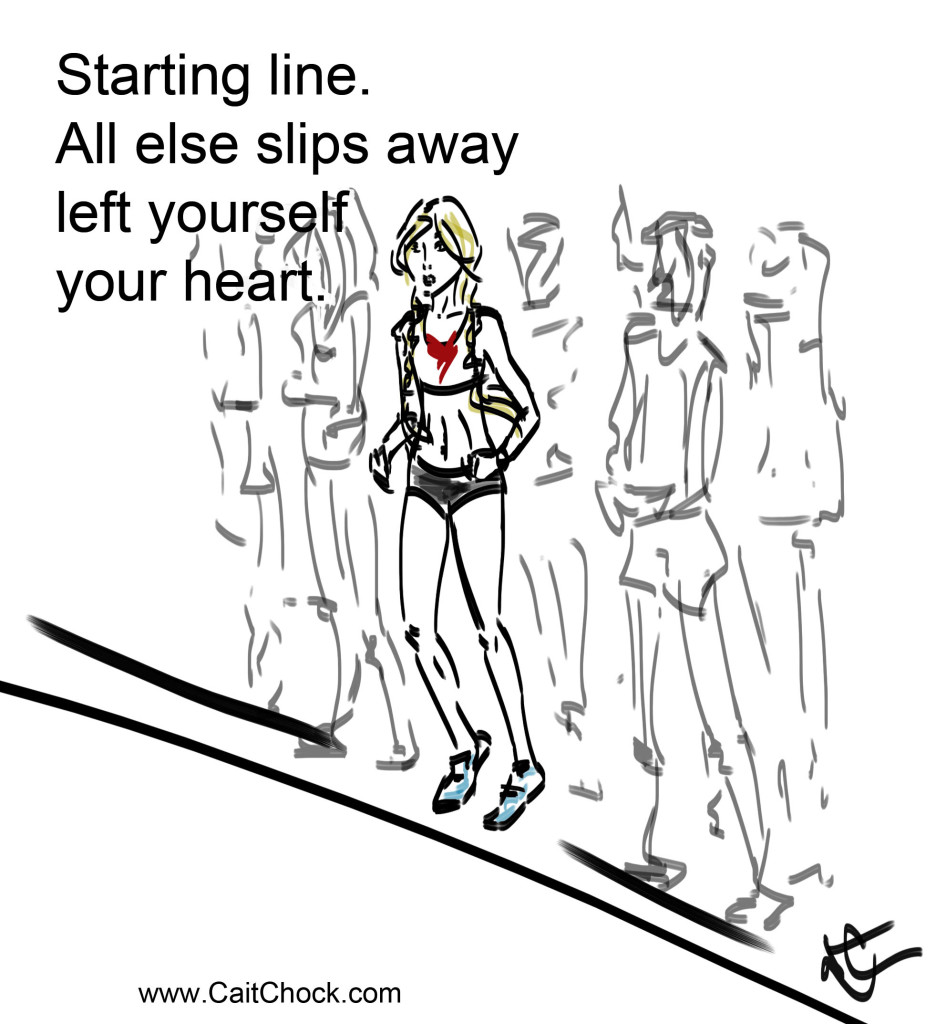
———
More posts on MOTIVATION
Another post on Starting Line Confidence and How to Build Yours
Talk about one cute chicker from the weekend!! This super fast runnerchick was the top female and 5th overall in just her first 5k!! Can you say natural born runnerchick?! At least her Ezzere Get Chicking Tee gave them a warning…keep on smoking those runnerboys. 

————-
1) What’s usually one of the last things you do RIGHT before the gun goes off?

Our minds are experts in construction. They will build up fences quicker than nobody’s business. It’s actually a survival method, the brain ‘thinks’ it’s looking after our best interest, keeping us safe by setting limits.
The problem is that this survival method is archaic and antiquated, most of the fence-building is stopping us from pushing ourselves in work or running rather than stopping us from trekking too far from our caves, getting lost, and gobbled up by a dinosaur. 

In breaking down your fences you are freeing yourself. Because on the other side, THAT is where you can push yourself to your best. The other problem with fences is that they stop you from even dreaming, or imaging that something epic is ‘out there’ that YOU could possible accomplish THAT! Fences keep you safe, in a comfort zone, they also suck because they rob you of really feeling and experiencing.
We can easily relate this to running in a few ways:
1) Goals: if your goals aren’t big enough to scare you a bit, they should be bigger. That said, you should know that working towards something BIG is HARD. That’s the point, that’s what makes an accomplishment fulfilling though. Just don’t be fooled into thinking there won’t be times where you want to stop…that’s where true self-motivation and dedication is tested.
2) Going in over your head: everyone needs to be in the position of going in over their head, a few times, and get comfortable with the fact that, “Yea, I might bonk” because, “Yea, I might not bonk and break through to a new level.” There are times in races where you need to not look at the clock/watch/split and just race, get swept up in the faster group…this can be in workouts too.
Confidence is a funny thing for a runner, and the watch can do wonders for it but it can also sabotage you if you ‘think’ about it too much. Example: “Holy crap!!! We’re running XXX pace, I can’t hold this…what am I doing running with these people, I don’t belong here?!!” This runner can either be intimidated by the splits or check in with themselves and realize they were actually feeling fine until they freaked themselves out. They might blow up later, but they may not, they may have their best workout yet. Either way though, sometimes you need to just stick your neck out there, break the fence.
Important to note that, duh, you shouldn’t always go on some kamikaze mission in workouts and races. I mean, a 7 minute miler shouldn’t go workout with the 4 minute miler group…let’s be sane here. The point is that for the most part, runners DO need a little push every now and again to break through to the next level. Surrounding yourself by some faster people is a great way to do that.

3) Mental ‘fences’ pain signals: for runners the vast majority of fence building is stationed around hard workouts and races. Your brain wants to STOP pretty much the second you start…haha. Steve Magness wrote a really great post all about the brain, willpower, emotions, and how that relates to a runner’s mental toughness. It’s a long read but incredibly interesting, worth it, and touches on quite a few different points, tackling it from multiple angles.
He talks a lot about willpower and how fatigue is actually an emotional response rather than a physical one. Really interesting because when you think you’re ‘tired’ it’s really only your brain reacting, worrying that you’re GOING to be too tired later to finish and shouldn’t continue. He goes on with lots of ways a runner’s willpower and mental toughness to combat the pain signals from the brain are affected. Things that make us more easily swayed to stop rather than push.
Proper recovery like nutrition and sleep are two factors…another reason to think of your training in the big picture sense. But another big mental toughness inhibitor is stress. He phrases it more as using your willpower reserves up on less important matters, but the explanation is that your brain can really only handle so much. The more taxed your brain is going into a workout or race, the less it will perform. Read as: the weaker it goes into the race, the more likely you are to cave to its complaints to relent, slow down, or stop.
Go read his full article HERE because really, there’s so many interesting points that make you think. A runner’s mental toughness is something most all of us are fixated on because it’s not finite, it’s kind of like an intangible that’s hard to explain with science. But Magness is actually able to show how science is closing in on giving us some cool explanations and theories.
The bottom line is: Runners, scr*w those fences. Start breaking them down and in doing so you’ll find that’s where the truly epic sh*t lies.
——-
More posts on MOTIVATION
——-

.jpeg?picon=3498)
By: Cait,
on 5/24/2014
Blog:
Cait's Write...
(
Login to Add to MyJacketFlap)
JacketFlap tags:
tips,
running,
videos,
goals,
training,
track,
exercises,
races,
workouts,
race tips,
Add a tag
Everyone wants to run faster, right? Part of getting faster is of course doing the shorter repeats; one must build that explosive power of course. BUT, there’s another part to getting faster and it’s training your BRAIN and nervous system to respond at a quicker rate.
A runner can’t utilize that explosive power to run faster without the nerve and synapse networks first being created to ‘tell’ your foot to move faster off the ground. Isn’t science and the brain cool?
The neuromuscular part of training isn’t something every runner is aware of, but if you’re not addressing it you can run all the 200′s in the world and not really be tapping into your full potential. I’ve written a few articles about the neuromuscular training and how it relates to runners:
* The Multi-Level Approach to Getting Faster
* Work on Getting Faster in Tri-Fecta Form
One of the exercises I mention are ‘Quick Feet Box Taps’. I got an email from someone who wasn’t quite sure if they were doing them right so I decided to make a little video.
You can also find it on my Instagram page. Start with a set of 15-30 seconds and see how many taps you can get. REMEMBER it’s QUALITY over quantity. If you’re getting slopping you’re going to start reinforcing bad habits and that will defeat the purpose. Work up to two sets and do the 3 times a week…preferably as part of your dynamic warm-up routine before workouts or immediately following the workout. It can be fun to watch yourself improve with more taps every week…you know us runners and that competitive spirit.  But again, quality over quantity…so if you have to start slow that’s what you need to do!
But again, quality over quantity…so if you have to start slow that’s what you need to do!
What, you love my shirt too?! Well, thanks…it’s my Ezzere Runner Face Tee! 
Happy Saturday my runner friends. Get those feet firing off the ground, coupling neuromuscular training and speedwork, and watch your PR’s get faster! 

.jpeg?picon=3498)
By: Cait,
on 5/22/2014
Blog:
Cait's Write...
(
Login to Add to MyJacketFlap)
JacketFlap tags:
track,
races,
race tips,
tips,
marathon,
running,
motivation,
goals,
training,
Add a tag
For runners, finding that perfect taper and method to peak right sure can be difficult! Which sounds kinda crazy because taking the taper at face value, one could think, “Well, I just need to cut back. I’ve done all the work, so let’s just coast on until race day and wind up with fresh as daisy legs!”
WRONG. Any runner can tell you tapering is a bit of a beast. Sometimes your legs do feel an extra bounce, other times they start feeling like dead weights and you start to freak out, “What the heck, why am I trucking bricks?!”

Some runners even build a little superstition around it, “The worse my legs feel on the warm-up the better they feel in the race.’ Not going to lie, I’ve experienced that one and can back the logic.
So let’s talk taper. We’ll even start from the most basic of basics up.
What is a taper? Training is done in phases, working backwards from the date of your big race. The closer you draw to your race, the more the goal of workouts shift from ‘building fitness’ to ‘sharpening’ and ‘honing’. A week before your race you’re not going to be able to increase fitness anymore, that work’s been done, so it’s a matter of maintaining fitness and then reducing the volume so your legs feel fresh come race day. [Tapering can be done anywhere from 1-3 weeks before your race, depending on distance and all that good stuff.]
Logistics: Runners who are tapering will cut their overall miles back, the volume of workouts decrease, and you’ll see workouts like 200′s, 400′s, or for marathoners, maybe a few longer repeats (ie: miles) at race pace. Just getting the wheels turning.

Common Mistakes:
1) Not decreasing enough:
If you’ve been training at 110 miles per week and your ‘taper’ is cutting down to 100 miles per week that’s really not going to leave you feeling all that fresh, right? Same goes with pushing your ‘taper’ workouts too much; grinding out your best 6xmile four days before your race day isn’t doing you any favors.
2) Decreasing too much: So the runners who think, oh I’ll just go from 110 miles down to 20 and I’ll feel GOLDEN! Wrong-zo. The body has a crazy way of adapting to us crazy runners and doing what we do. Dramatic shifts, the body doesn’t like that at all. Go too far from one extreme to the other and your body will be like, “wtf is going on?!” In the case of the runner above, they’ll actually be feeling sluggish because their body is used to much more stress. It actually NEEDS more miles to feel better. Crazy, huh? But kinda cool too.
Bottom line: There’s no perfect amount for everyone, it comes back to what works for you and your race distance. But a nice rule is that when tapering your mileage should be reduced by 20-25% of your average training volume.
3) Pre-Race Day Off: Many runners like to take the day before their race completely off. I would like to argue that, they should instead take the day TWO days prior to their race off. Why? Sometimes your legs will feel stale after a complete rest day, it’s better to do a short shake-out run and strides the day before to ‘bust out the rust and creaks.’ You still get a day off, but going into the race you’re not ‘creaky’. This is also why if you’re running a night race, lots of runners like to do a short (10-15min) shake-out run that morning.
4) No Speed-work: Taper logic might seem like you shouldn’t do anything hard…go into the whole week totally fresh and rested. Refer back to number 2 and realize that once your body has become accustomed to a certain degree of work (ie: stress) it needs the stimulus. Going 4-plus days without any faster turn-over will leave your legs feeling sluggish and slow. For races 10k and below, a good workout to do three days before your race is 8x200m with 200meter recovery. Any way you slice it, you still want some ‘sharp’ quality sessions leading up to your race.
Tapering is a tricky science, that’s why I firmly believe runners should have a coach they trust to do the sciencey planning stuff. Then the runner isn’t left ‘thinking’ all this out. Planning and wondering “is this workout right? Is this what I should do?” can get in the way of your workouts, and it can be liberating to give that ‘stress’ to someone else who KNOWS their stuff.
That way, runners can just turn their brain off and stick to what they love to do…run. Hey, running the workouts are hard enough, no reason to add more thinking than necessary to the mix. 
———-
More posts on RACE TIPS
More posts on PRE-RACE CONFIDENCE
Make sure you’re looking GOOD doing all that training…Ezzere’s got your back there! 

———

.jpeg?picon=3498)
By: Cait,
on 5/8/2014
Blog:
Cait's Write...
(
Login to Add to MyJacketFlap)
JacketFlap tags:
races,
race tips,
tips,
running,
training,
track,
motivation,
goals,
nutrition,
Add a tag
Now my younger brother’s first love is rugby, second is football, but for the three weeks between seasons he decided to do track! Wahoo…I was stoked!! I’m also in awe of the fact that he doesn’t do any speed-work and then just blitzes those 400′s and 200′s like they’re nothing.

The mystery is solved as to where all of the fast twitch muscle fiber genes in the family went. Clearly all were saved and concentrated into the youngest Chock sibling. Oh and I guess he stole my coordination genes too. 
Granted he’s got the competitiveness of a Chock, so he’ll gut out a race and pay the price after to hit those marks. But the truth is that last 100 of a 400 isn’t fun for anybody, no matter if you’ve trained or not…BLECH…talk about booty lock.
Checking out those high school meets has been fun, observing just as much so, and here are a few tips I’d pass on if teenagers actually cared to listen to us old folks:
* Warm-up and Recovery:
set yourself up to run your best, not warming up before a race is setting yourself up for
both injury and running below your maximum potential. Cold muscles no likey sprinting. The same for after your race, do all you can to recover so you can come back stronger. That includes a cool-down and
refueling within 30 minutes of finishing.
* Drafting and Tangents: it was windy at the track meet and those are days where you really want to draft. Leading expends more mental energy and on windy days it expends a heck of a lot more physical energy to lead. If you can, tuck in behind somebody until you’re really to surge past them. When you DO make your move, try to make it on a straight away…running the tangents on a race course is the same idea, don’t run more than your race distance or your competitors are.

* When You Pass, You PASS: racing is mental like that, when you make a move and pass someone you want to be passing them for good. Conserve energy and then blow by that sucker! Don’t ‘weakly’ pass them because then they can just tuck in behind you and let you do the work. You want to BLOW by them and try to mentally break them. Make them think, “Dang, they’re feeling much stronger than me, I can’t keep up.” Even if you feel like crap, it’s a race, you should feel tired, but your competitors don’t have to know you’re tired as heck and clinging on until the finish line. Break them and leave them in your dust.
* Cling-on: sorry, no sci-fi reference, but this speaks to those getting passed. Read above. You can’t get in the mind of your competitors and chances are they’re working, tired, and hurting too. If they pass you, rally the troops and try to stay with them. Don’t let THEM mentally break you. See, it works two ways like that. 
The last thing I’ll add, while I like to joke that I have not a single fast twitch muscle in my body (I’ve never been biopsied, but I’ll say I probably only do have one!) DON’T use that as an excuse to avoid speed-work. It’s incredible how much you can manipulate and overcome your natural predisposition in terms of speedster versus endurance maven. You’d be surprised that, yes, even ye of one speed can get some wheels on themselves and wind up with really strong kicks.
The thing is you just have to train those muscles! For speed you need to build power (hills, sprints, plyo’s) and all that good stuff is plenty of fodder for another post!
Get out there and kick some butt…embrace the booty lock too! 
——–
Have you checked out my Ezzere Running Tees yet?? Mosey over, folks!!
Send MAJOR cheers to one awesome Kim @ Day with KT this rockstar runnerchick and mom is out to kill it at her 50 mile race this Saturday!! WAHOOOO!!!

.jpeg?picon=3498)
By: Cait,
on 4/26/2014
Blog:
Cait's Write...
(
Login to Add to MyJacketFlap)
JacketFlap tags:
races,
Sunday Morning Inspiration,
sunday morning motivation,
marathon,
running,
comics,
Cartoons,
motivation,
art,
drawing,
goals,
Add a tag
Really, need I say more?
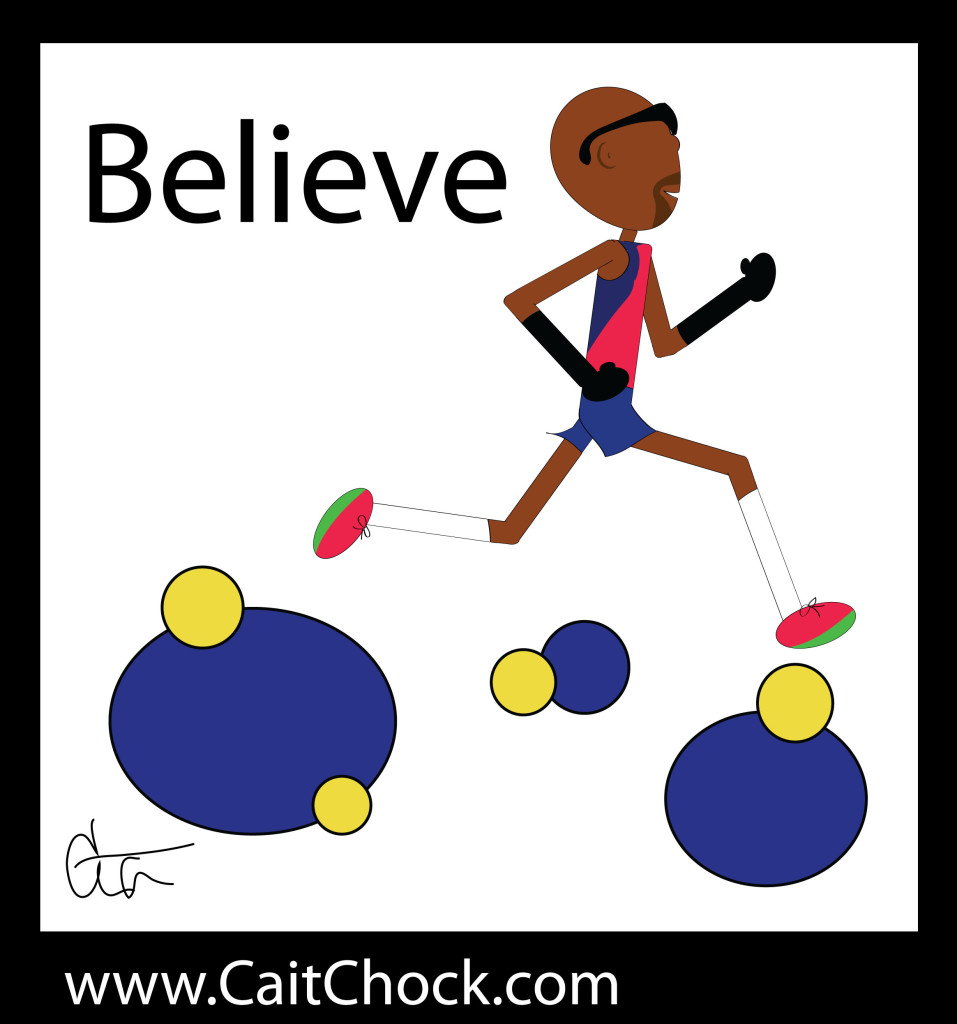
#run #mebstrong
————
More Running Motivation HERE

WEAR your motivation and be reminded of your goals with an Ezzere Running Tee!
———-

The moments leading up to a race are this crazy mix of emotions: excitement, anticipation, terror??, chomping at the bit eagerness, hope, motivation, forced relaxation (attempted??)…flip, you name it! Poised at the starting line, every runner can relate to the feeling that they just may burst if that freaking starter doesn’t fire the gun! CRACK!!
Adrenaline, cortisone, hormones flooding the body. This is the internal environment of your body before the start of a race. This is stress on the body. I read an interesting article in Fast Company, it’s actually a business piece and questioning if the brain can actually be addicted to stress.

This is your face yelling at the starter to just, “FIRE THE GUN!!”
After-all, stress puts the body into that fight or flight mode. I think everyone can relate to the rush you feel when you’ve waited until the LAST second to hit a deadline…some people are even convinced that their best stuff comes under that gun of procrastination. But stress is physical, the brain releases certain chemicals, the nervous system operates differently.
The same happens with runners. Many of those same chemicals are coursing through your veins leading up to races, and even workouts. We know those feelings, we know that buzz, and heck, I’ll totally agree that feeling is addictive. Why do you think us runners keep signing up for races, go out to nail that next workout, we love the rush that comes with it. Mostly the rush that comes AFTER…but the whole experience in itself is darn-right thrillingly addictive.
The problem though, is putting your body through that entire hormone/chemical crazed onslaught is wearing. Your body would literally explode (well, probably not literally actually) if it was in that heightened state forever. And the body DOES start to deteriorate if you put and keep it in that state for too long.

Add some hormones to those bones and we’ve got it.
This is where runners get into trouble when they let their nerves get the better of them and they (literally) explode in races and workouts. Bwahahaha…when I say explode here, I’m actually meaning implode. They Bomb.
You have to keep all that nervous energy in check. As an athlete you need to, to a degree, control the release of all that adrenaline, cortisone, and all the other crazy hormones. Overriding that body’s natural instinct of fighting or flighting mode is difficult, and takes work. Naturally some athletes are just BETTER at mentally managing that, they’re the gamers. The trickier thing is, as with natural talents, describing HOW they do it isn’t something they can really put into words. They just DO it.
Though controlling your race and workout day nerves is still a skill that is totally possible. And just like mental toughness, it’s a skill that every runner continually hones and learning to get better at is a process. You find tricks that work, not everything works for everyone…and it’s like trial and error. This is where you take any and all bad races/workouts and use them to your benefit. Did I learn something that didn’t work here? Did I learn, then, what I’m going to try next time to make things work? Looking for key lessons from bad workouts includes both physical and mental things.
A bit of a personal thing here, I’ve always loved racing. That feeling is fan-freaking-tastic, and (this never happens, brace yourself, I never blatantly give myself a compliment. Ever. I’m working on that, but I’m petrified people will think I’m bragging! So I want to preface this with I’m not bragging, but this is something I’m kinda proud of.) when I was racing I was able to manage and handle that race day nervous energy well and perform better than my workouts suggested. So I’ll kinda share what I think helped me….I always remembered this:
Interestingly the calm slips away the moment the gun in fired. I think THAT, the wanting to just get into the calm zone, at least for me, was most of the reasons my skin would crawl, itch, buzz, wanting…craving the gun to just go off. Let’s just start doing this thing!!
Anticipation is always the worst feeling. In a roller coaster, it’s the anticipating the drop that sucks, the oddly freaky sensation of your stomach lifting, that’s the fun part. Just like running where we battle the love-hate relationship with the pain of racing, it’s a love-hate thing with that stomach dropping feeling. I think a big part of the nervous anticipation is that we KNOW there is a tug-of-war about to ensue…and we (hope we are!) want to be TOUGH enough when the true test comes. We know we’ve been tough before and loved/embraced that sensation…so we need to remind ourselves we will be just as mentally tough again and come through with sailing colors. Knowing that the crack of the gun will unleash the inner gamer in us all, is reassuring.
It’s the anticipating, wait for the gamer to come out, that makes us want to grab the starter pistol and fire it ourselves! With the CRACK come the relief…the release. The moment that happens, our bodies know what to do. What, as runners, we’ve conditioned them to do. With the crack of the gun we FINALLY, liberatingly are free of thinking.
1) Stress…love it, hate it, think you can be addicted to it?
2) Do you think runners are ‘addicted’ to the feeling of racing and workouts?
3) Do you think my little anticipation theory is anywhere close to something that resonates with you?

Oh, the faces of the poor runners who went out to fast and are paying for it. #bootylocksucks

Kinda crazy how it hits you like THAT…no slow slip into lactic acid h***…nope, you’re feeling fine, then BAM!!!
Please, Runners, take a cue from these poor guys. Runner PSA: NEGATIVE split. 
——-
More race tips HERE
——-
1) Worst bootylock experience?
2) Funniest bootylock experience?
3) How many times did it take you to learn not to get sucked into going out too fast?
We all have to learn the cruel way a few times…

Racing is a fierce sport. Take no prisoners. Competition.
Racing is
thrilling
spine-tingling
adrenaline
pushing
pressing
competing.
Pain. fighting. lactic acid.
MENTAL TOUGHNESS

Running is a test. Against yourself. Your competitors are there to PUSH you to your best.
Competition is a gift. THEY will elevate you, take you places you didn’t think you could go. PUSH you past pain thresholds your mind told you you’d never go.
Racing is fierce. It’s better than a blood sport, it’s a game of wills. You are the pawn, the King, the Queen, and dictator.
You control what the body puts out. Be fierce. Be strong.
Be a competitor.
You amped yet? Good luck to anyone and everyone racing this weekend…track season is always so freaking exciting! 
——–
NEVER fear your competition…they are there to help you. Read more…
Race day tips HERE
A little dark or serious today? More posts on MOTIVATION and CARTOONS 
——–
1) Finish these sentences: Race day is…
2) When I think of my competition, I…
3) I am in control of my race, I know I’ve put my best out there by…

.jpeg?picon=3498)
By: Cait,
on 1/24/2014
Blog:
Cait's Write...
(
Login to Add to MyJacketFlap)
JacketFlap tags:
running,
motivation,
art,
goals,
injuries,
intervals,
races,
facing fears,
race tips,
bad races,
Add a tag
Sometimes a runner’s already won the race before the gun’s even goes off. Questions. Doubts. Insecurities. None of these belong at the starting line; starting line of a race or a workout. A runner needs confidence. NEEDS it… no amount of physical endurance, speed, or fitness can make up for it.
How one steps to the line is what separates the GAMERS from the runners who perform at about the level they do in workouts, and then harriers who self-implode.

Confidence is a tricky one, it’s a mental factor of running and training. Once shaken, a runner’s confidence can be quite difficult to fully restore. Injuries, off days, strings of bad races, all of these plant seeds of doubt. Doubt is like a monster that, once you feed it, it grows exponentially in size. It’s a voracious monster that will eat a runner whole. Step to the starting line enveloped in that ugly monster and you might as well not even wait for the gun to crack. You’re already a dead runner ‘running’.
By the time you step to the starting line, there is NOTHING you can change about the past. Stop any questions of, “Should I have done…?”, “Did I do enough…?”, etc. You can’t do it, so no use worrying about it.
Don’t let that scare you off, if you’ve got some doubts, that’s only natural. And if you’re currently fighting from falling into the pit with that ugly doubting monster, THERE IS still hope for you yet. It works two ways. You CAN restore your confidence. You CAN still step to the line a gamer. It just takes some work and shifting your thinking.
Usually doubts start from one of two places:
1) An Event: Events would be after injuries, poor performances, etc…it starts with a legitimate reason to question if your fitness is off and snowballs. Usually the first race or workouts back after an injury a runner naturally goes in with a little more trepidation. You need some solid performances under you belt to steamroll that confidence train back.
To help BOOST that train, remember that your talent and fitness never goes away. Your first race back may not be your PR, but trust in the process, trust in your dedication, and trust that you’re only going to improve from here.
2) Anxiety and Stress: Anxiety and stress tend to spike around pre-race time. I wrote whole posts HERE and HERE on how to use those nerves to your advantage. If you let too much pressure, internal and external, load you up, it’s like running with a weight vest. To help unload that pressure, usually it takes the runner looking within THEMSELVES and finding that passion and love for running that brought them to the sport. If they can get back the excitement and joy for just running, eventually the times, workouts, and races will get back on track.
Ironically, the LESS you think about races and workouts, typically the better you’ll do.
Remember that NO race is the last race in the world. Yes, it can be a Championship race or a PR you’ve been wanting to pop FOREVER…but know that tomorrow will always come and another race will too.
1) Where do you draw your confidence from before a race?
2) How do you use a race day atmosphere to BOOST your performance compared to regular workouts?
3) Have you ever had a time when your confidence was shaken, how did you get it back?

Santa rocked my runner socks off.  If you’re following me on Instagram you probably already saw my awesome new purple Garmin…wooohooo!! My old Garmin actually broke a week before Christmas in what I can only call the sum of all fears for a runner: I had no warning, I was in the middle of a run, I was in the first mile of a tempo.
If you’re following me on Instagram you probably already saw my awesome new purple Garmin…wooohooo!! My old Garmin actually broke a week before Christmas in what I can only call the sum of all fears for a runner: I had no warning, I was in the middle of a run, I was in the first mile of a tempo.
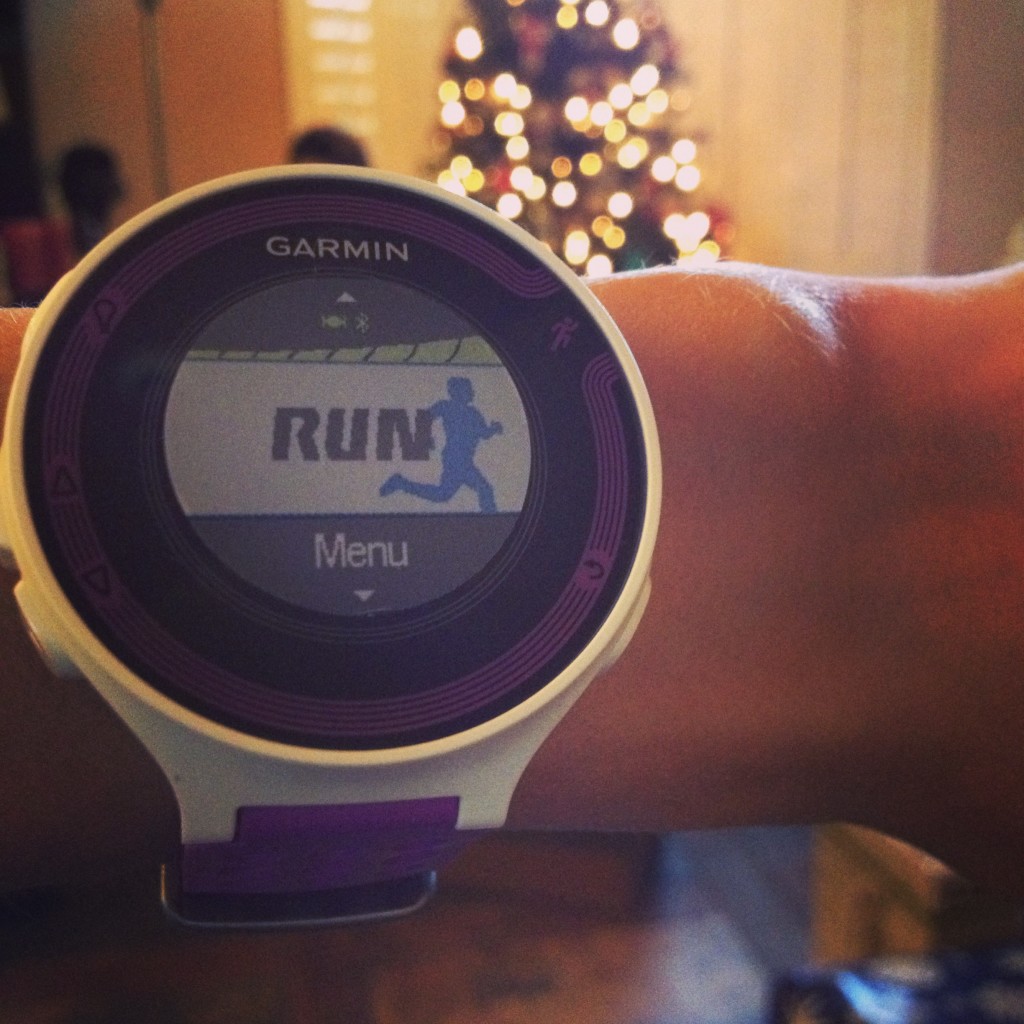
Needless to say I was P*$$ed!! Hello, this OCD runnerchick would have liked to know her splits. Alas, alas…I did survive which does remind us all of two important lessons:
1) It’s in the Effort: Yea, I had no idea what my miles ended up being but I still ran hard. Times and splits are helpful information when it comes to workouts, but they don’t always tell the full story. Bottom line is it all comes back to the effort.
2) Times NOT to Time: While I certainly hadn’t planned on my Garmin crapping out, I have talked before about times when it’s better NOT to run with a watch. Easy days are meant to be easy and running ‘naked’ on those days can help keep them as such, not worrying about pace. Sometimes runners can get too stressed about their hard workouts, getting too anxious about time times, if they aren’t hitting the splits, etc. If you’re started to dread your hard workouts because of the stress, running without a watch is an easy way to unload a ton of self-imposed stress. Run hard. Scr*w times. Again, it’s coming back to effort.
Sometimes running without a watch can be freeing.
But back to my story, I DID want the watch…haha. So I was peeved when it died and was crossing all my fingers and toes that come Christmas I’d be gifted with a new one. HURRAHH!! When I ripped into that package I did jump up and do a happy dance. I am 27. I runnerchick nerded out, and I’m not even ashamed.
I christened that baby after all the other presents were opened…yes, I was kindly patient so the rest of my family could get to their gifts too. 
While the holidays can rock your socks off, they can also be stressful or tough for people too. Here is where running can certainly do wonders to keep you sane: literally pound out all the frustration. But it can still be stressful and stress sucks, it can eat you alive from the inside out.

So let’s talk stress and how it may apply to runners:
* Derail Workouts: Getting back to my watchless example, type-A runners can fall into the trap of thinking themselves out of a workout. This thinking includes: “Those times are WAY too fast, there’s no way I can hit those!”, “I’m dying, I can’t do all those repeats”, “WTF?!?! I’m running my butt of and the times are STILL too slow.” It’s a slippery slope and it has a snowball effect, eventually you get nervous and fearful of every workout, you dread them, and it’s your brain [more than your body] slowing you down.
* Pre-Race Nerves: Racing is fun but it also comes with a certain level of stress. Some of that nervous energy is GOOD, but it’s a fine line between ‘just enough’ and waaaay too much. THIS POST is all about how to keep those nerves in check and not derail your race because of stress and self-imposed pressure.
* Training Rut: Slogging through weeks and weeks of runs where you’re not ‘feeling it’ and not feeling that spark for running can be a sign that you’re burned out. Reach that point and you’re stressed because you’re not LIKING running and it feels like a chore. Taking breaks after seasons is one way to avoid getting burned out, THIS POST covers other reasons for that ‘meh’ feeling and how to get your spark back for running.
Running should be kept fun, it should make you want to do those nerding out happy dances. Don’t let stress suck out that joy…and certainly don’t let a mid-tempo Garmin death get you down. The world kept on turning, which was a little reminder I [double uppercase for emphasis] needed that running is WAY more than just about the numbers.
…but the numbers are nice so once again, THANK YOU, Santa!!
1) How were your holidays?
2) Is there anything that’s been stressing you out as of late? How have you dealt with that?
3) When’s the last time you ran watchless?

Today’s run started out like crap. You know the feeling, your legs are wobbling around herky-jerky style and in your mind you feel like a fish out of water. You think, “Good gracious, it’s like these things have never run a step in their lives before!”
Oh the ‘beautiful’ first mile of the not-as-young-as-they-used-to-be runner. It’s almost like you can hear the creaks and pops while the body is cracking off the rust, akin to the running Tin Man. 

But you warm us runners up and thanks to the TRUE beauty of muscle memory the fish fins transform back into your actual running legs. Then though, there are just those days. The legs warm up but they still feel like a load of junk, much heavier than they ought to feel.
It happens, all part of the game, and on days like that you just put in the effort. Remember that ‘meh’ runs happen to even the best runners in the world, then look forward to the next run.
HERE is where things get interesting and we can pull a little actual science into this running businesses. Because there ARE ways to turn a heinously ‘meh’, craptastic run around…now not always, yes, craptastic runs will always exist, but if that first mile is particularly heinous don’t lose all hope yet!
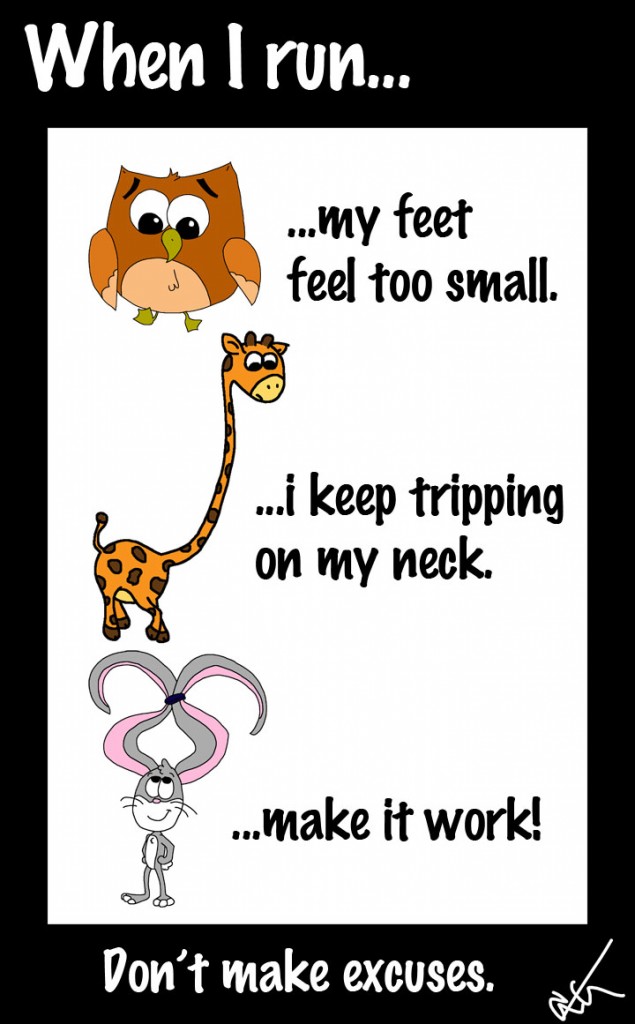
Super Science Stuff…but not in sciencey lingo
* Two Energy Systems:
Distance runners work primarily off of their endurance, cardiovascular system, for the majority of their miles. Easy runs, warming up, cooling-down, even longer distance intervals and races. You get the gist, we’re not out there putting in 100 meter repeats and taxing that anaerobic system.
* Gear Shift: Sometimes us distance runners get ‘stuck’ in a certain pace; get conditioned to that ‘easy’ run pace too much and you can wind up in a rut. When this happens that ‘easy’ pace doesn’t feel as ‘easy’ as it should. Now it sounds counterintuitive but to bust OUT of that rut, sometimes all you need to do is toss in a change of pace.
* Bust the Funk: If you’re thinking, “Running easy feels hard, no way in heck running faster is even possible at this point!”…bear with me. Toss in some strides, a few relaxed surges, then settle back into your easy pace. The gear-shift will have tapped into that other energy system for a bit and two things will happen:
1) The shift caused your muscles to work in a different way, giving a little ‘break’ to the endurance-heavy system. Little breaks feel good, right, those muscles will appreciate letting the other energy system do a little work.
2) Settling BACK into easy pace will feel, well, easier. This is thanks to switching gears but also that easy pace really IS relatively easier than the faster surges.
KA-BAM!! Better run!
It’s funny that sometimes the answer to turning a really craptastic run around is to just play around with the pace, but it’s true. I did the exact thing on my run today and ended up NOT feeling like a fish stuck on the shore. Flip. Flop.
Give it a shot. There are also TWO very important times to remember that a change of pace can leave you feeling like you’ve got much fresher, faster legs:
1) Warming up before a race:
Legs can feel like crap during the slow warm-up,
bust off some of that sluggishness with strides, and miraculously you’ll feel bouncy after the gun goes off.
2) The Beginning of a Race: Sometimes the beginning of a race can still feel harder than it should, but
DON’T give up right away, or use that as an excuse to not put in the effort. Try the same change of pace trick and bust out of the funk.
Keep on running, Runners, hopefully less craptastically! 
1) Have you ever tried surges or strides mid-run to bust out of a rut?
2) Have you ever had a race where the beginning you thought you’d run horribly but your legs starting feeling better later on?
3) What is one trick you use to get through craptastic runs when they happen?

Runners get thirsty: drink. Runners get hungry: eat. But, as with most things that seem idiot-proof, the most basic of basics, two of the most rudimentary bodily functions can often turn into a runner’s nightmare. I just finished an article for Competitor providing the perfect example of this: “Got Stomach Issues? You’re Probably Dehydrated”.
What’s interesting, and as you will learn from reading the article, it’s often not FOOD wrecking havoc on your stomach and intestines during your hard or long runs. It’s the (not) DRINKING thing that’s giving you a GI nightmare! Talk about a whodathunkit moment, right? 

I’ve been a runner for years and years and still, learning that dehydration is the culprit to most GI problems, both the upward and the downward, came as a bit of a surprise. But if you think about it, it really shouldn’t be; let’s look at what happens when you run:
* Muscles working: Brain and body prioritize the hard-working muscles as the top-tier function at the moment.
* Body delegates: In moving the muscles to priority number one, the stomach, intestines, and anything digestive related gets bumped down.
* Blood to muscles: All the major blood-flow gets shunted to the muscles, leaving the stomach and delicate intestinal tissues simultaneously deprived of blood-flow. This lapse in blood causes slight damage. Aww, poor, intestines. 
* Dehydration: Now water is INSANELY important to the body, it makes up darn near most of it, so NOT having enough water content in the blood stream exacerbates the damage caused to the already weakened stomach and intestines.
* The Backlash: Need I say more?
Runners experience those GI disasters, up and down, because the stomach and intestines are already deprived of blood-flow while you’re running and then on top of that if there isn’t enough water content in the body to begin with, they stage a major revolt.
Bottom line: It doesn’t matter what kind of food you’ve got in your stomach or intestines, if a runner isn’t hydrated, that food can’t be digested so it’s coming out…pick a direction.
Solution: Duh, Runners, stay HYDRATED!  I jest, I jest, kind of…but the reality is, many times runners underestimate just how much fluids they need. What’s more, when I say fluids that includes more than just water: also electrolytes.
I jest, I jest, kind of…but the reality is, many times runners underestimate just how much fluids they need. What’s more, when I say fluids that includes more than just water: also electrolytes.

The tricky thing with hydration is, once you’re dehydrated and experiencing the effects of it you’re already on a sinking ship. Kind of like it’s too late at that point; that’s why it’s IMPERATIVE you stay in a constantly hydrated state and remain that way through the duration of your hard workout or long run.
Staying hydrated during long runs, and marathon geared workouts, means taking in fluids and replenishing those stores at a steady rate. Read the article for some awesome tips from Molly Pritz and Krista Austin, Ph.D., on how to come up with a personal hydration regimen.
See, you think relying on those little “I’m thirsty” cues is enough to keep you hydrated. But the truth is, especially for runners, by the time you FEEL thirsty you are already in a state of dehydration. So go chew, err sip, on that. 
1) Had you been aware dehydration could be the culprit of you GI problems?
2) Especially in the heat GI problems become more common, how do you make sure to stay even more conscious of fluid consumption when it’s hot or humid?
3) An upset stomach after a hard or long run can be common too, and traced back to dehydration. What are some of your go-to ‘safe’ foods for restoring and repairing those muscles AFTER your runs?


Getting a runner to be faster is an interesting undertaking. It’s actually a concept that coaches and athletes have been trying to perfect for centuries. As science has improved, training has evolved, we’ve created training phases and workouts that push the runner and train their body.
Simplistically it’s easy to sum it up like this: if you want to run faster, run faster. This is true of course, doing speed work and improving your base speed, is going to enable a runner to run a faster pace as the distance gets longer. As in, if you improve your mile time you’ll be able to run a 5k and 10k faster. If you don’t do speed work you’ll never improve your speed.

Though as I said, that’s overly simplistic, and if a runner is truly wanting to see how fast they can be they need to open their eyes and expand their training logs to include ALL of the factors that make a runner faster. You see, the body is an interconnected machine, you can’t just concentrate on straight running workouts.
I’ve been working on a series for Competitor.com tied to speed work and the other techniques that enable a runner to, well, run faster. There are drills, strength work, and a neuromuscular component to getting faster.
Check out the series so far:
What Distance Runners Can Learn From Sprinters
The Neuromuscular Component to Speed Work
Distance Runners Staying SHARP During an Injury
In reading each of them you’ll see that the first step to getting faster is working on your shorter-repeat speed. You shouldn’t avoid those 200′s even if you’re a 10k and above runner. But that’s ONE step in the process.
After that you’ve got to build the synapses and teach the nerves to fire faster; your brain is ‘telling’ your legs and foot to move faster. But if you don’t build the connections the ‘message’ won’t be able to travel faster from brain to foot.
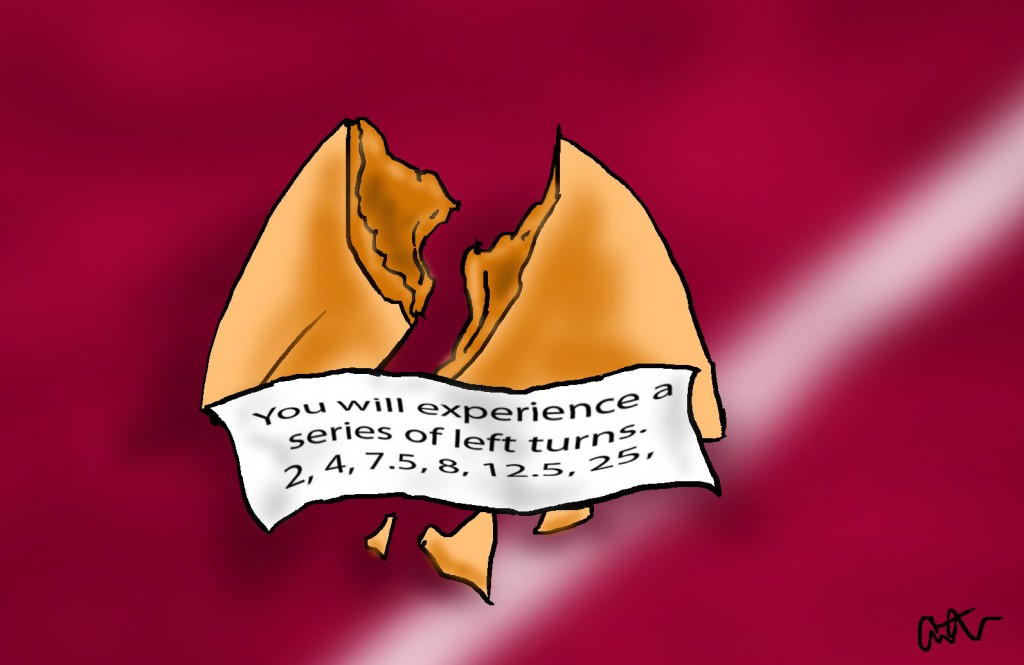
A runner’s form is also related, and the articles touch on that. Running faster takes POWER and EXPLOSIVE propulsion from your muscles. Your muscles also need to be ‘waken-up’ and eased into the movements of running. That’s why a proper warm-up is so important for your had workouts and races. There will be more on that specifically in upcoming articles.
So if you’d like to run faster, even if you’re a marathoner, it’s important to realize that it’s a multi-pronged approach. It will take time too, but consistency is the law of distance running and THAT is what will, in the end, take you to the next level.
Consistently incorporate speed work, speed-endurance, and endurance work into your training.
Consistently be working on your core and strength routines.
Consistency with foot-firing and ladder drills that play off of the short speed sessions.
Practice, improve, and then have a coach or be a student of the sport if you’re training yourself.
Without going on a long tangent, a big mistake many new runners are making is getting swept up in marathon and mileage mania. They just want to do more, more, more. That’s fine, but if you want to get faster you need to TRAIN to run faster. That’s where quality of miles becomes more important than just quantity.
I hope you enjoy the series so far and keep on the lookout for the next ones. Running is an action that can be broken down to be incredibly simplistic: left, right, left. Running faster can also be thought of in simple fashion: run faster. BUT it’s a lot more complicated, and to be honest insanely interesting, than just that.
To run faster you’ve got to be training your body to do so on multiple levels.
1) What’s a concept about speed work that you have learned from this series so far?
2) Have you done any work geared toward training your neuromuscular system to get you faster? Or is this a new idea to you?
3) If you’re training to get faster, what are some of your ‘staple’ speed sessions?


Lately it feels like my brain is running way faster than my legs could ever keep pace. That’s a darn shame, because one would certainly opt for running a new PR rather than mentally shouting, “SHUT UP!” to your brain at 2am and imploring it to go to bed. 
Speaking of PR’s, track racing season is getting to be in full swing. Some people have a bit of a phobia when it comes to the track, others find the monotony of double-digit laps, well, monotonous. The thing with track though, is it BLEEDS speed…as a runner, how can you not love that?

Each distance is unique, duh, the number of laps to the race you’ll be running presents its own challenges. The ratio of speed to endurance, the contrast between utter lactic ONSLAUGHT from the gun versus the more gradual building of the pain in the 10k. Both grueling, just in a different way.
Each race has a ‘volatile’ factor. This would be the crucial moments and laps that can make or break your race. The margins of time where if you’re not ON IT you may have very well lost the race even if you’re still got laps and laps to go.
There’s not just ONE moment in time of course, but for the sake of brevity let’s highlight a few of the volatile factors for the events:
* 1500/Mile: That dang third lap. Here is where the pain of the pace has already set in, the ‘taste’ of the finish isn’t quite close enough to kick in. Your mind starts to dauntingly anticipate that grueling last lap. COMBAT: Know that third lap is going to suck, know that it will make your race if you can pass the people letting their brain wander.
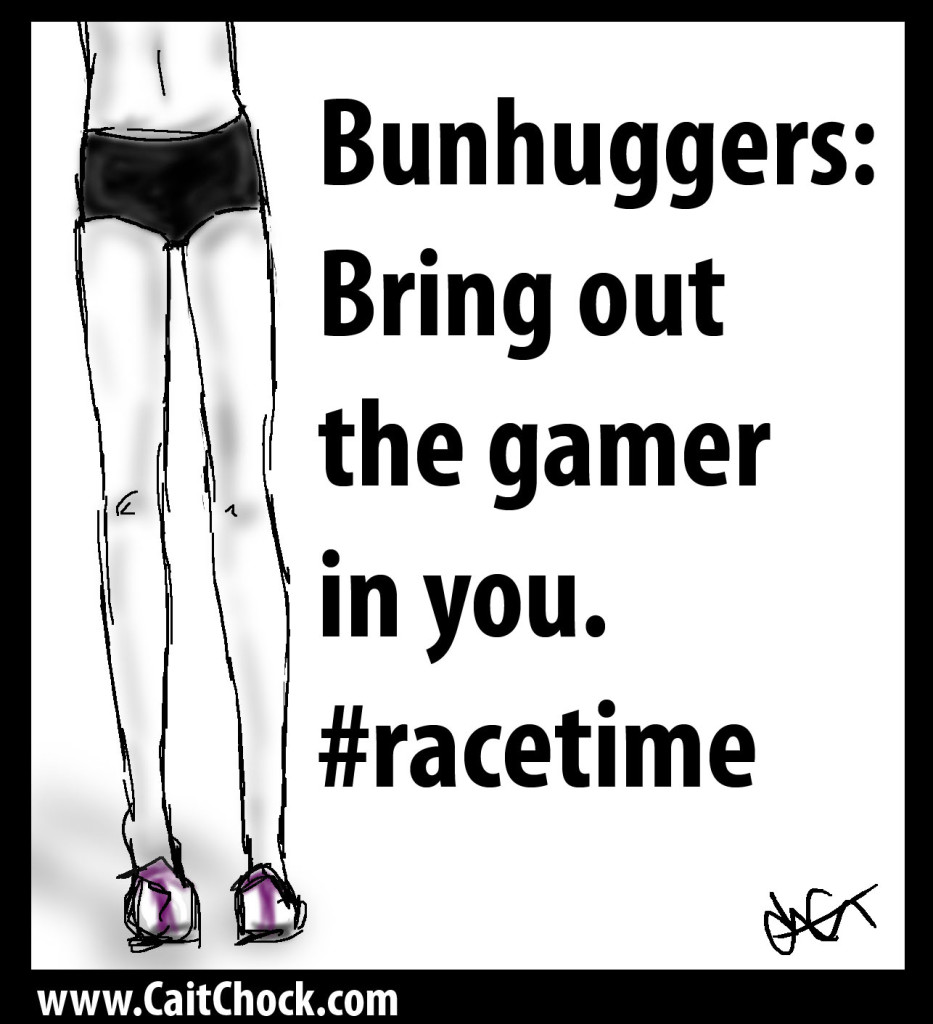
* 3200: Right around laps 4-6 it is easy to let your brain check-out. It’s prime time to make a move, surge and establish a gap on those who either went out too fast for that first mile or the poor souls who are just letting their mind wander. COMBAT: Go out on pace the first mile and throw down a move…remember the beauty of negative splits.
* 5k: It’s funny how running that first mile can feel so easy, a breeze, too easy. The middle mile is where you need to wrangle your brain and keep it FOCUSED. Much like the 3rd lap of the mile, the middle of your 5k can lapse into a fog if you’re not careful. COMBAT: Don’t let yourself get pulled out too fast the first mile, stay mentally engaged the middle mile, and anticipate the cold slap of pain somewhere after the second mile. It’s funny how it can suddenly sneak up on you, but be prepared for it and stay strong through to the finish.
Each race has its own set of ‘volatile’ factors…that’s what makes each and every track distance so fun. It’s a test, as is everything with running, testing mostly yourself. The competition is there as an opportunity to propel your performances forward…feed off of their presence.
Track is awesome, just don’t let the distance of the race pull a fast one on you. Be prepared and then enjoy the unique challenges of each event.
1) What is your favorite track distance to race?
2) Pick a distance I didn’t highlight and share one of their ‘volatile’ factors.
3) Share a ‘volatile’ factor that I didn’t address for one of the above races.


The runner’s warm-up is a unique time. Before a hard workout, and even more-so for a race, there’s a lot that needs to happen both physically AND mentally.
A warm-up tells your legs to ‘wake up’ because they’re about to start running fast. Gradually notching down the pace, starting with the relaxed running, prepares the legs, rather than a complete SLAP in the face…the shock of a hard 400 off the bat. Got a bit of the lazy bug or backwards thinking towards the warm-up? (ie: Thinking that you’re ‘saving energy’ for the workout/race is backwards logic…hehe)

* Physiologically: Those super expensive cars can brag about going 0-60 in seconds, but your body doesn’t work that way. Sort of like you wouldn’t want to get ripped out of bed and chucked into the middle of a tempo run, your legs need time to adjust to, “Okay, time to run,” then “Okay, time to run FAST!” The science behind it can get wordy, but basically muscle function and glycogen burning (sourcing energy) works most efficiently when done through negative splits. Start slow (ie: running a warm-up) and work into those faster paces.
* Feels ‘easier’: Thanks to that science, your muscles, once introduced/eased into that pace, will make the same times feel relatively easier. You will be able to then run faster off of a proper warm-up. I think all runners are down for that.
* Mentally prepare: The warm-up is also a time for runners to get their heads on straight. Visualize what you want to accomplish during the workout, quell those nerves and keep them in check. Remember that you will stay relaxed and controlled when the pain is setting in.
What is a ‘real’ warm-up?
Studies are proving there should be more elements to your warm-up routine than just some easy running. Runners want all of those muscles alert and engaged before the hard running starts.
* Easy running: Aim for at least 15 minutes, I like at least 2 miles under my legs.
* Dynamic stretching: Do some good stretching, here is where the more dynamic ones like leg swings are perfect.
* Drills: Skips, fast feet, etc. A series of drills will wake up the nervous system and get your legs firing faster. [I did an article on that HERE]
* Strides: Here is where you start to bring the pace down with a series of strides. Stay controlled and make each one progressively faster.
By the time you hit the line for that first interval or race you want to feel loose and ready to go. You don’t want to ‘waste’ the first interval, or mile of your race, because you’re still warming-up.

Get your head on right. 
A runner’s warm-up is a process; over time you want to have the series of elements (stretches/drills/etc.) down so well you could do it on auto-pilot. This routine establishes continuity for your muscles but it also gives your MIND something concrete to focus on.
Focusing on the routine of your warm-up is an effective way to stay calm beforehand, rather than get overly worked-up with nerves. Especially on race day, by the time you start your warm-up you should feel ‘safety’ with it…it’s something that is the SAME, that you’ve done over and over again. Proof that you’ve made it through plenty of hard workouts, managed to fight through the pain, and you’re capable of doing that again.
A runner’s warm-up is the little cup ‘o joe the body needs to perk the heck up and get ready to run fast…it’s also a time to get your head on right and ready to tackle that workout or race! 
———-
The Boston Marathon tragedy is still haunting our thoughts and flooding runners with emotions. I am continually reminded of the good in humanity, in stark contrast to the horrifically dark side. While we will never be able to understand why or how a person or persons may be driven to lash out in this manner, hold tight to the reality that for every ‘bad seed’ there are many more with good intentions and of a benevolent manner.
Keep running united, keep running for Boston, and keep supporting all effected as best you can!
———-
1) What’s your warm-up routine look like?
2) How do you use your warm-up to get your head screwed on right and ready to roll that workout/race?
3) How has your warm-up evolved over the years?
For most it’s gotten longer…haha.
4) What is something you’ve seen/heard/read that help shed some light over this recent tragedy…or given you some hope for humanity?
The immediate coming together of runners all over, and not just runners either.


It’s been over 24 hours since yesterday’s horrific incident clouding the Boston Marathon, yet I’m still unable to put the right words down. I was not there, so anything I can add is merely an abstract opinion; though I do believe everyone is entitled to their own thoughts and feelings.
In the build-up to Boston, just like all other running fans I was excited. The Boston Marathon is one of the biggest, in name, numbers, and history. I wrote about it, shared one of it’s most legendary runners’ perspectives on it, and held hope that an American Woman would finally bring a win back to the States.
I was charged with anticipation; that’s one of the great things about the running community, I, thousands of miles away from the starting line, was able to ‘taste’ just a smidgen of the electric energy swirling around Boston.
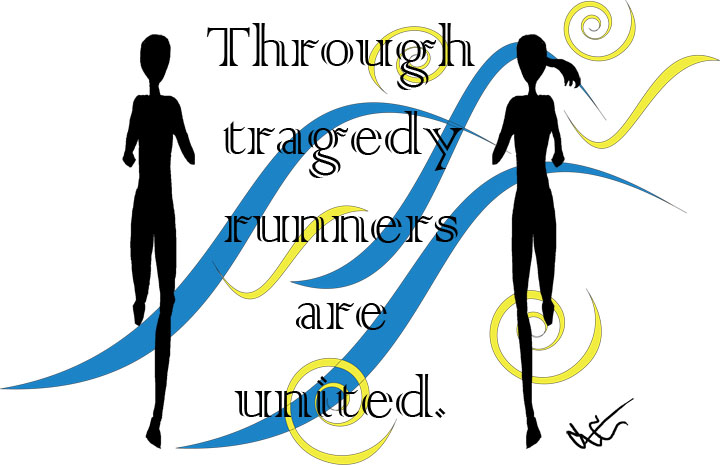
While an American Woman didn’t bring home a win, in the first wave of finishers the closeness of the running community and shared kinship, especially between training partners, was displayed poignantly by Kara Goucher’s and Shalane Flanagan’s finishes. They wanted to know how the other did.
Runners are able to understand each other in a unique way. Even if they are strangers, even competitors on the same course, they are able to sense things about the other…words unsaid, with a glance. There is something to be said for shared agony, suffering, whatever in the heck you want to call the ‘pain’ of racing.
And then it happened. I am thankful that no one that I immediately ‘know’ was harmed. But I feel that as a part of the running community, that isn’t quite correct. A runner knows a runner.
A runner also knows just how crucial a support network is. So a runner knows the supporters, spectators, cheerers, and any spirit moved to absorb the electric atmosphere of the Boston Marathon.
I was not there. I can’t even begin to understand the ‘whys’ behind this and I can only imagine what it was like to be there.
Though, I try my best to find what positives there can ever be. There isn’t a positive in this case, but rather just a glimmer of something redeeming. I will say this, here is this legendary event holding wonder and lore and now it is stained with this awful cloud.
Rather than let the smoke and ashes suffocate the event and the running spirit, we are able to come together, mourn the tragedy but not let it erode our kinship and sense of community. The 2013 Boston Marathon will no doubt be one of those things forever tinged with loss, sadness, and no doubt anger.
Though it will not stop us from running. It will not revoke the meaning behind the marathon. Don’t let the anger swallow you, don’t entirely lose hope for humanity yet, be thankful for what you have, those precious moments of life and the ability to run for another day. Not that running is the end-all by any means…it wasn’t running that was the target, but I’ve always found running a loyal companion to take me through life’s hardships.
Hold your loved ones dearly, let them know. Hold you ability to use your able body quite dearly too. Runners are instilled with an indomitable spirit, a fortitude like none other, but a closeness to each other quite unique.
Runners will do what runners do…run through the hardships to get to brighter times.


View Next 13 Posts









































































